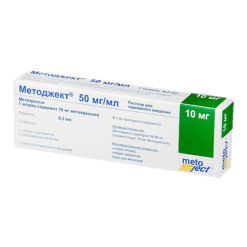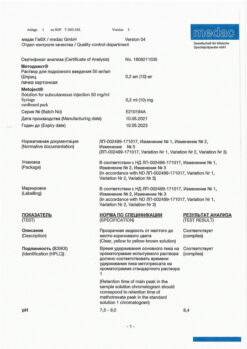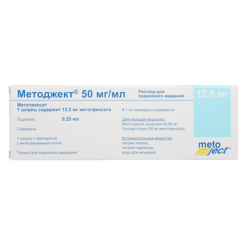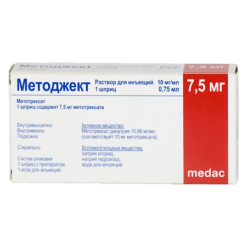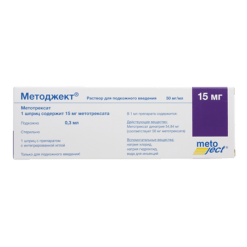No products in the cart.
Description
Metodect, a cytotoxic drug, is a folic acid antagonist and an antimetabolite. It has antitumor and immunosuppressive effects.
Indications
Indications
– rheumatoid arthritis in adults;
— polyarthritis in patients with severe juvenile chronic arthritis in active form;
– severe generalized forms of psoriasis and psoriatic arthritis in adults when standard therapy is ineffective.
Pharmacological effect
Pharmacological effect
Metoject is a cytotoxic drug, a folic acid antagonist, an antimetabolite. Has antitumor and immunosuppressive effects.
Active ingredient
Active ingredient
Methotrexate
Composition
Composition
1 ml of solution for subcutaneous administration contains:
Contraindications
Contraindications
– severe liver dysfunction;
– alcoholism;
— severe renal failure (creatinine clearance less than 20 ml/min);
– a history of hematopoietic disorders, such as bone marrow hypoplasia, leukopenia, thrombocytopenia, severe anemia;
– severe acute or chronic infectious diseases such as tuberculosis, HIV infection;
– ulcerative lesions of the oral cavity;
– ulcerative lesions of the gastrointestinal tract in the active phase;
– severe immunodeficiency;
– pregnancy;
– lactation period (breastfeeding);
– simultaneous vaccination with live vaccines;
– hypersensitivity to the components of the drug.
The drug should be used with caution in patients with ascites, dehydration, obstructive gastrointestinal diseases, pleural or peritoneal effusion, and chronic renal failure; for parasitic and infectious diseases of a viral, fungal or bacterial nature (currently or recently suffered, including recent contact with a patient) – herpes simplex, herpes zoster in the viremic phase, chicken pox, measles, amoebiasis, strongyloidiasis established or suspected (risk of developing a severe generalized disease); with gout (including a history) or urate nephrolithiasis (including a history), infection and inflammation of the oral mucosa, vomiting and diarrhea (fluid loss due to severe vomiting and diarrhea can lead to increased toxicity of methotrexate), gastric and duodenal ulcers, ulcerative colitis, with previous chemotherapy or radiation therapy, asthenia, in elderly patients.
Side Effects
Side Effects
The most common side effects when using Metoject are reactions from the hematopoietic and digestive systems.
Determination of the frequency of side effects: very often (≥ 1/10), often (≥ 1/100, < 1/10), sometimes (≥ 1/1000, < 1/100), rarely (≥ 1/10,000, < 1/1000), very rarely (< 1/10,000).
From the digestive system: very often – stomatitis, dyspepsia, nausea, loss of appetite, increased transaminase activity; often – mouth ulcers, diarrhea; sometimes – enteritis, vomiting, cirrhosis, fibrosis and fatty degeneration of the liver, hepatotoxicity (acute hepatitis, liver failure); rarely – erosive and ulcerative lesions of the gastrointestinal tract; very rarely – vomiting mixed with blood, bleeding from the gastrointestinal tract (including melena, hematemesis); Possibly pancreatitis.
From the hematopoietic system: often – leukopenia, anemia (including aplastic), neutropenia, thrombocytopenia; sometimes – pancytopenia; very rarely – agranulocytosis, severe suppression of bone marrow function.
Dermatological reactions: often – exanthema, erythema, dermatitis, itching; sometimes – photosensitivity, baldness, enlarged rheumatic nodes, vasculitis, infections caused by Herpes zoster, herpetiform skin rashes, urticaria; rarely – increased pigmentation; very rarely – changes in nail pigmentation, acute paronychia, Stevens-Johnson syndrome, toxic epidermal necrolysis (Lyell’s syndrome). When treating psoriasis – a burning sensation of the skin, rarely – painful erosive plaques on the skin.
Allergic reactions: various manifestations up to anaphylactic shock; allergic vasculitis, fever.
From the cardiovascular system: pericarditis, pericardial effusion, pericardial tamponade, decreased blood pressure, thromboembolism (including arterial thrombosis, cerebral vascular thrombosis, deep vein thrombosis, retinal vein thrombosis, thrombophlebitis, pulmonary embolism).
From the central nervous system and peripheral nervous system: often – headache, feeling of fatigue, drowsiness; sometimes – dizziness, confusion, depression; very rarely – pain, muscle weakness or paresthesia of the limbs, impaired taste (metallic taste), convulsions, meningism, paralysis.
From the endocrine system: possible – diabetes mellitus.
From the senses: conjunctivitis; very rarely – visual impairment (including transient blindness); Possibly ringing in the ears.
From the respiratory system: often – interstitial alveolitis/pneumonia, symptoms of potentially serious interstitial pneumonia (dry non-productive cough, shortness of breath and fever); sometimes – pharyngitis; rarely – pulmonary fibrosis, pulmonary pneumocystis, pulmonary insufficiency and bronchial asthma; possible – pleural effusion, nosebleeds.
From the urinary system: sometimes – inflammation and ulcerative lesions of the bladder, painful urination, hematuria, hyperuricemia, renal failure; rarely – severe renal failure, oliguria, anuria, azotemia.
From the reproductive system: less often – inflammation and ulcerative lesions of the vagina; very rarely – vaginal discharge, loss of sexual desire, impotence, oligospermia, menstrual irregularities, infertility.
From the musculoskeletal system: rarely – arthralgia, myalgia, osteoporosis, osteonecrosis, increased risk of fractures; Possibly soft tissue necrosis.
Metabolism: increased sweating, hypogammaglobulinemia; rarely – electrolyte imbalance.
Infections: possible – life-threatening opportunistic infections (including Pneumocystis pneumonia), cytomegalovirus infections (CMV) (including CMV pneumonia), sepsis (including fatal), nocardiosis, histoplasmosis, cryptococcosis, infections caused by Herpes zoster and Herpes simplex (including disseminated), impaired wound healing.
Neoplasms: in some cases – the occurrence of lymphomas. A recent study did not find that methotrexate therapy increased the incidence of lymphoma.
Local reactions: when used intramuscularly – a burning sensation at the injection site, the formation of an aseptic abscess, destruction of fatty tissue.
The frequency and severity of side effects of methotrexate treatment depend on the dose and frequency of use. However, severe side effects can also occur with low doses of methotrexate, so it is necessary that patients receiving methotrexate undergo regular medical examination at short intervals.
Manufacturer
Manufacturer
Oncotech Pharma Production GmbH, Germany
Additional information
| Manufacturer | Onkotek Pharma Production GmbH, Germany |
|---|---|
| Medication form | solution |
| Brand | Onkotek Pharma Production GmbH |
Other forms…
Related products
Buy Metoject, 50 mg/ml 0.4 ml with delivery to USA, UK, Europe and over 120 other countries.


